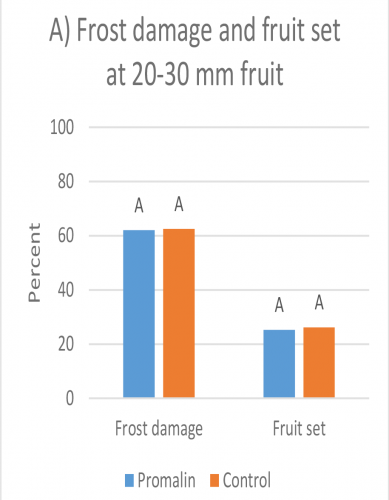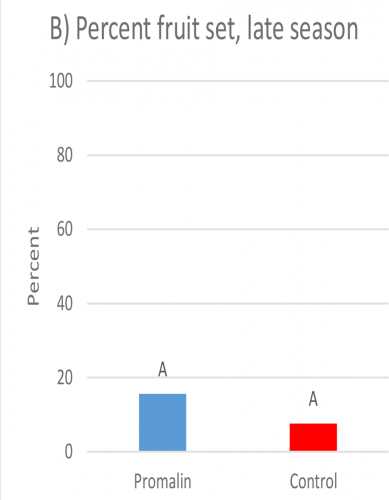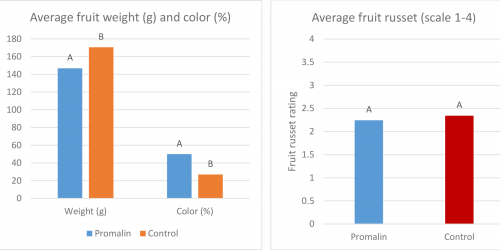How did Idared apples respond to Promalin after the 2017 spring frost?
Results of a common post-freeze practice on commercial Idared apples in 2017.
Promalin, manufactured by Valent BioSciences, is commonly used by apple growers after freeze events that occur during bloom to promote fruit set from damaged flower tissue that would not otherwise survive to set a crop. This product contains two distinct gibberellic acids, GA-4 and GA-7, as well as a cytokinin, 6-Benzyladenine. These three plant growth hormones are designed to promote various elements of cellular division in plant tissues, leading to higher survivorship of freeze-damaged blossoms.
While this product has been on the market for over 20 years, the unpredictable nature of spring freezes makes replicable study on the outcomes of this product difficult. As a result, we have only scattered experiences as an industry in understanding how this product behaves on specific apple varieties, and what degree growers can expect to see benefit based on the severity of the freeze event.
Following the freeze events during bloom on May 8 and 9, 2017, this product was used by many Michigan growers in efforts to combat damage to the apple crop. Following these applications, four apple varieties at commercial sites in west central Michigan were followed through the growing season and compared with controls at the same locations to measure effects on fruit set, diameter, mass, color, russet, seed count, average seed number and incidence of parthenocarpic fruit. Rome, Idared, Red Delicious and SweeTango were the selected varieties.
This three-part Michigan State University Extension article series summarizes the results for the varieties, in addition to a brief synopsis of the environmental conditions during and immediately after the freeze events. To read the summaries of the other varieties tested, see “How did Rome apples respond to Promalin after the 2017 spring frost?” and “How did SweeTango and Red Delicious apples respond to Promalin after the 2017 spring frost?"
On May 8, the Idared site used for these trials recorded 5 hours below freezing with a minimum temperature of 23.2 degrees Fahrenheit. On May 9, another 5 hours below freezing was recorded with a minimum temperature of 28.5 F. Promalin was applied at 1 pint per acre in the morning on May 10. Following the application, daily high temperatures rose to 66.1 F on May 10, 64.4 F on May 11 and 64.4 F on May 12.


Figure 1. A) Frost damage and the percent fruit set at 20-30 millimeter fruit stage. B) Late season for control and treatment groups. Independent t-tests, p>0.05.
Frost damage was uniform in treatment and control groups. This indicates that any differences in fruit yield observed in these trials is not due to differential frost damage. Fruit set between Promalin and treatment groups was approximately the same at the 20-30 millimeter fruit stage between control and treatment groups.
By late July, a numerical difference in percent fruit set between the treatment and control groups emerged. While not statistically significant, trees treated with Promalin averaged about 8 percent higher fruit set on measured branches than the control treatment in this field. While no initial differences in fruit set could be observed, these data indicate that fruits at this site may have hung on through June drop and mid-summer heat slightly better when treated with Promalin.
Again, this strays outside the realm of statistical significance, but these results are consistent with what was seen in most other research situations in 2017. A slight numerical increase that was not statistically different than a control was frequently observed with this product this season.

Figure 2. Average fruit weight (g), color (%) and russet (1-4) in control and treatment groups. Weight and color: Independent t-tests, p<0.05. Russet: Independent t-test, p>0.05.
Idared sprayed with Promalin at this location were significantly smaller than those in the control group. Promalin-treated Idared were also more highly colored than those in the treatment group. There was no difference in the severity of fruit russet between these treatments.
In general, Promalin application at this site resulted in slightly higher numbers of smaller, more colored fruit that were no more likely to be russeted than those that had not been treated.

Figure 3. Average seeds per fruit in control and treatment groups. Average seeds per fruit and incidence of seeded fruit: Independent t-tests, p<0.05
Fruits treated with Promalin had significantly fewer seeds on average and a higher incidence of seedless fruit. Idared fruits treated with Promalin were also significantly more likely to be seedless than those that were not treated with Promalin.
Summary
Idared treated with Promalin had slightly higher average yield in number of fruits per branch. Although not statistically significant, measured branches had about an 8 percent increase in number of fruits per branch on average, a similar pattern to the slight numerical increase recorded with other applications made in 2017 over the course of this study.
Fruits from trees treated with Promalin tended to be smaller, more highly colored, had fewer seeds on average and were more likely to be seedless. Promalin application to Idared appeared to increase the number of seedless fruits present on treated trees for this variety and under these environmental conditions. Fruits treated with Promalin were no more likely to be russeted than those that had been untreated.



 Print
Print Email
Email



